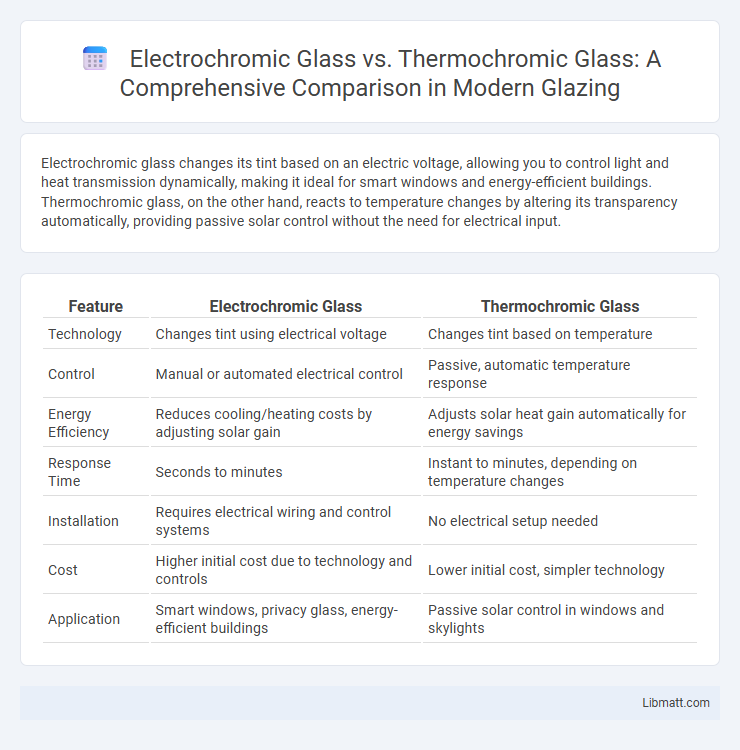Electrochromic glass changes its tint based on an electric voltage, allowing you to control light and heat transmission dynamically, making it ideal for smart windows and energy-efficient buildings. Thermochromic glass, on the other hand, reacts to temperature changes by altering its transparency automatically, providing passive solar control without the need for electrical input.
Table of Comparison
| Feature | Electrochromic Glass | Thermochromic Glass |
|---|---|---|
| Technology | Changes tint using electrical voltage | Changes tint based on temperature |
| Control | Manual or automated electrical control | Passive, automatic temperature response |
| Energy Efficiency | Reduces cooling/heating costs by adjusting solar gain | Adjusts solar heat gain automatically for energy savings |
| Response Time | Seconds to minutes | Instant to minutes, depending on temperature changes |
| Installation | Requires electrical wiring and control systems | No electrical setup needed |
| Cost | Higher initial cost due to technology and controls | Lower initial cost, simpler technology |
| Application | Smart windows, privacy glass, energy-efficient buildings | Passive solar control in windows and skylights |
Introduction to Smart Glass Technologies
Electrochromic glass changes its opacity or tint in response to an electrical voltage, offering precise control over light and heat entering a space. Thermochromic glass reacts to temperature changes, darkening automatically as it heats up to reduce solar heat gain. You can optimize energy efficiency and comfort by understanding how these smart glass technologies function and differ in their applications.
What is Electrochromic Glass?
Electrochromic glass is a smart glazing technology that changes transparency or tint when an electrical voltage is applied, allowing precise control over light and heat entering a building. This dynamic glass improves energy efficiency by reducing glare, solar heat gain, and cooling costs while maintaining natural daylight. Unlike thermochromic glass, which reacts to temperature changes, electrochromic glass offers user-controlled tint variations via automated or manual settings.
What is Thermochromic Glass?
Thermochromic glass changes its tint automatically based on temperature fluctuations, helping regulate indoor heat by blocking solar infrared radiation when warmed. This type of smart glass uses heat-sensitive materials that darken as temperatures rise, reducing glare and improving energy efficiency in buildings. You can enhance comfort and lower cooling costs by integrating thermochromic glass into your architectural designs.
How Electrochromic Glass Works
Electrochromic glass works by using a low-voltage electrical current to change the tint of the glass, allowing you to control light and heat transmission. This glass contains multiple layers, including an electrochromic layer that alters its opacity in response to an applied voltage. Unlike thermochromic glass, which changes based on temperature, electrochromic glass offers precise, on-demand adjustability for energy efficiency and comfort.
How Thermochromic Glass Works
Thermochromic glass changes its tint based on temperature, using materials that react to heat by altering their molecular structure, which modifies the glass's light transmission properties. Typically, this glass contains thermochromic dyes or coatings that darken as temperatures rise, reducing solar heat gain and enhancing energy efficiency. This dynamic response helps in maintaining indoor comfort by controlling glare and cooling loads without relying on electrical power.
Key Differences Between Electrochromic and Thermochromic Glass
Electrochromic glass changes its tint through an applied electrical voltage, allowing precise and reversible control over light transmission and solar heat gain. Thermochromic glass automatically adjusts its transparency based on temperature changes, darkening as it heats to reduce glare and heat without external power. Key differences include electrochromic glass offering user-controlled modulation and integration with smart systems, while thermochromic glass provides passive, temperature-driven response with less customization but greater energy savings in fluctuating environments.
Advantages of Electrochromic Glass
Electrochromic glass offers precise control over light transmission by adjusting tint with a small electrical voltage, enabling energy savings through reduced heating and cooling costs. Unlike thermochromic glass, which changes color only based on temperature, electrochromic glass provides on-demand shading, enhancing comfort and privacy. Your building can benefit from improved daylight management and lower glare without sacrificing views or requiring window replacements.
Benefits of Thermochromic Glass
Thermochromic glass offers dynamic solar control by automatically adjusting its tint in response to temperature changes, reducing cooling costs and enhancing indoor comfort without electrical input. This energy-efficient glazing supports sustainable building design by minimizing reliance on HVAC systems and optimizing natural daylight. Your living or working space benefits from improved thermal regulation and reduced glare, contributing to both environmental impact and occupant well-being.
Applications and Use Cases
Electrochromic glass is widely used in smart windows for residential and commercial buildings to control light and heat transmission, enhancing energy efficiency and occupant comfort. Thermochromic glass finds applications in automotive windows and skylights, dynamically adjusting tint based on temperature to reduce glare and regulate interior climate without external power. Both technologies contribute significantly to sustainable building design, with electrochromic glass offering precise control via electrical signals and thermochromic glass providing passive, temperature-responsive shading solutions.
Choosing the Right Smart Glass for Your Project
Electrochromic glass offers precise control over tint levels through electrical voltage, making it ideal for applications requiring adjustable privacy and energy efficiency. Thermochromic glass changes opacity based on temperature, providing passive solar control without external power, suited for environments with fluctuating heat exposure. Selecting the right smart glass depends on project-specific needs such as control preference, energy savings goals, and installation environment.
Electrochromic glass vs thermochromic glass Infographic

 libmatt.com
libmatt.com